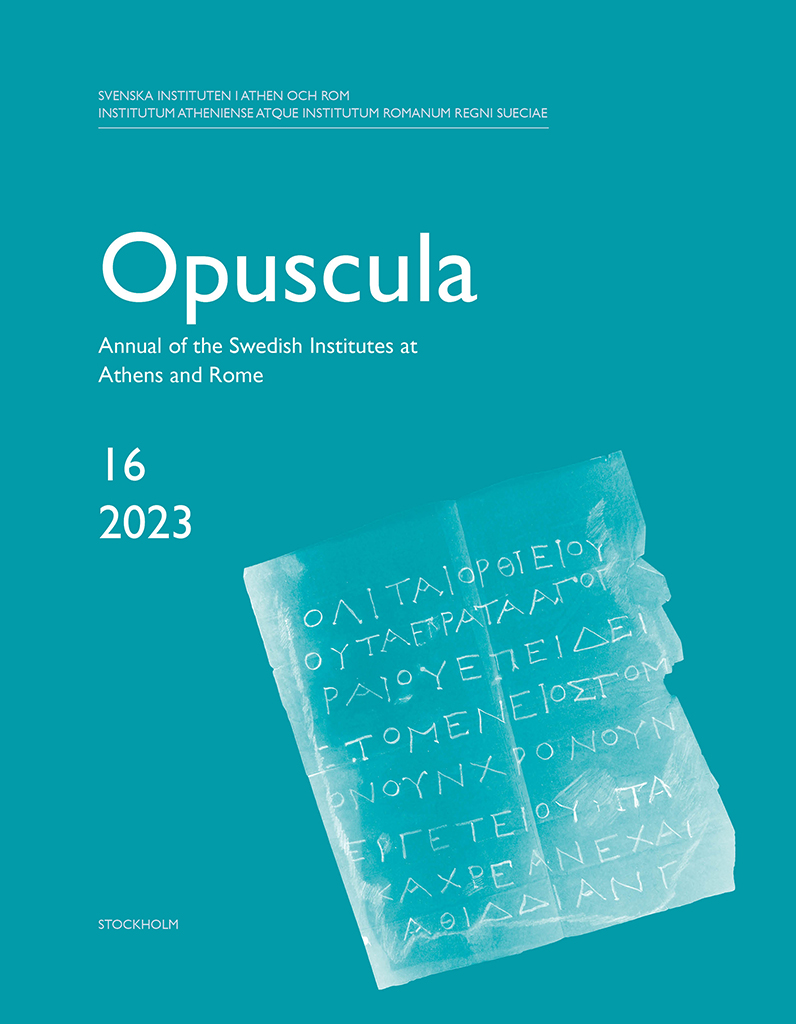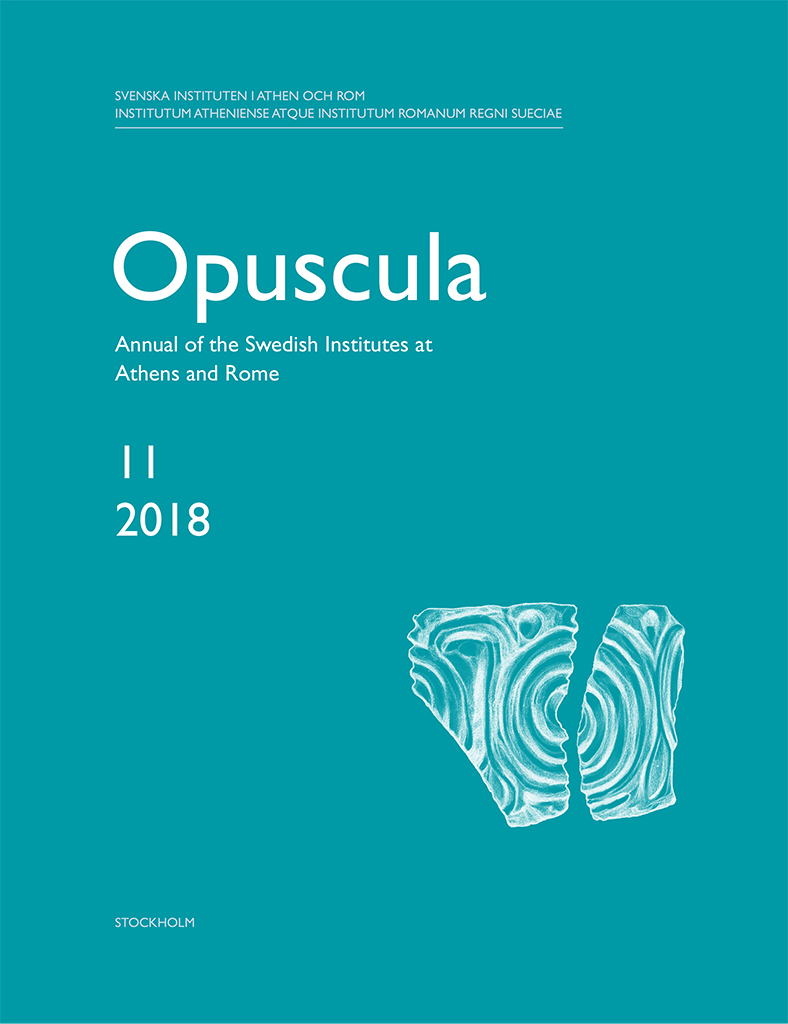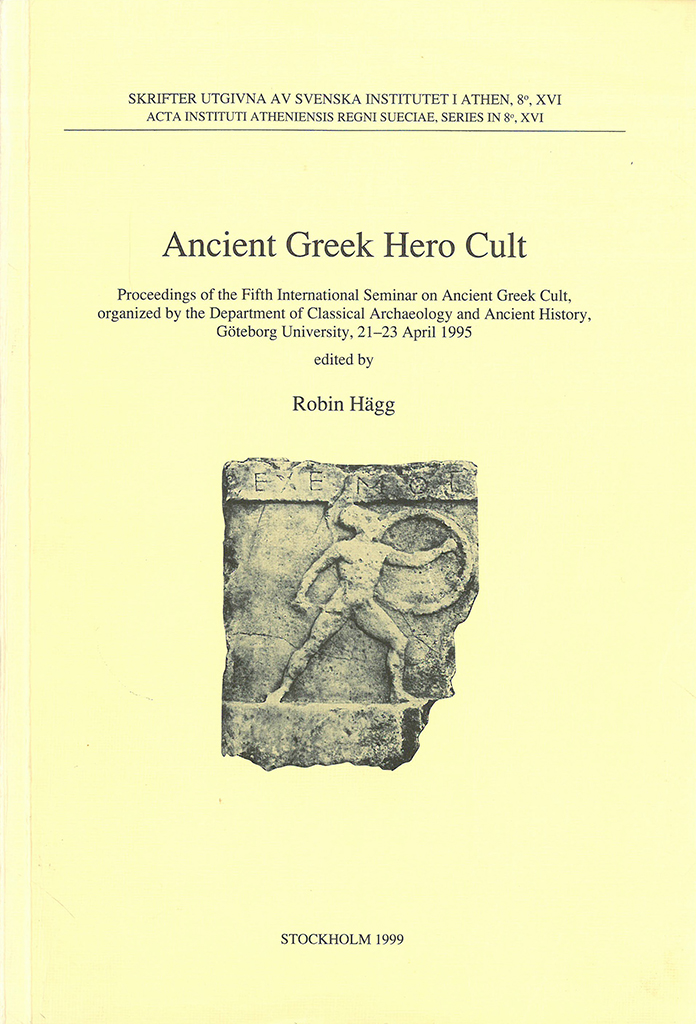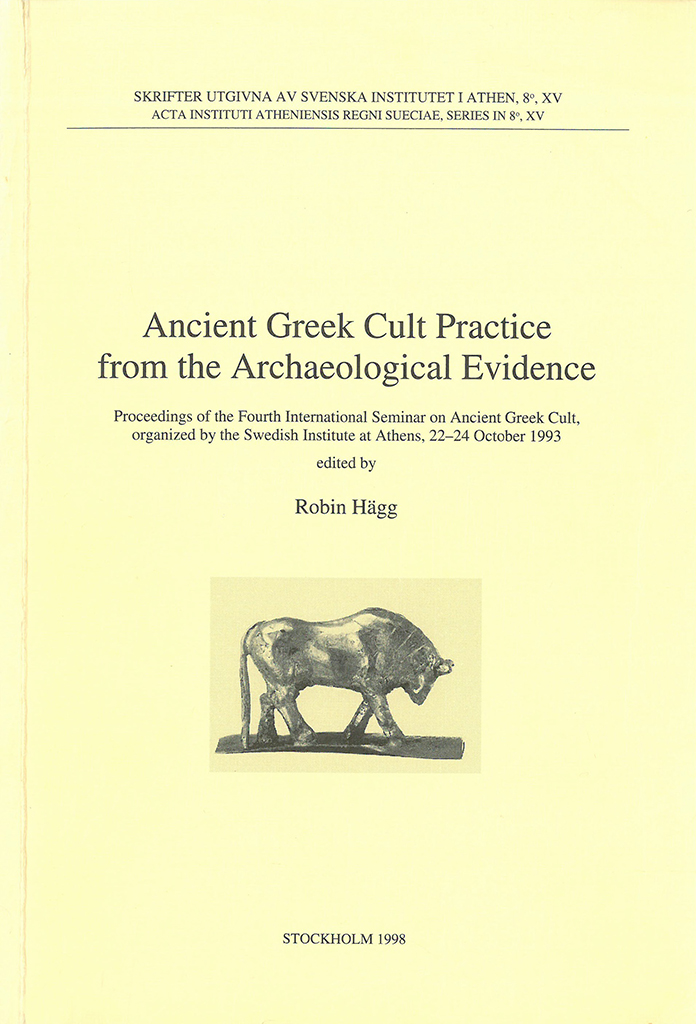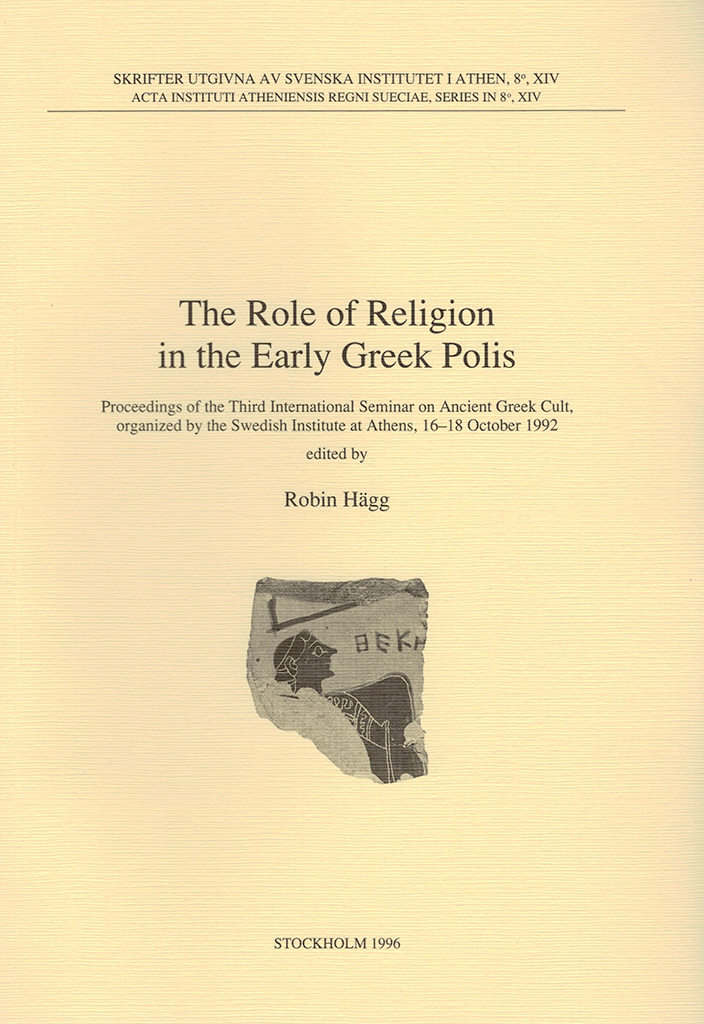Opuscula 16 is published by the Swedish Institutes at Athens and Rome. Distributed by Eddy.se AB. View volume at ERIH PLUS. All content available with open access. Statuettes of pregnant sows from Knidos. New light on the cult of Demeter By Linda Talatas Abstract Four marble statuettes of pregnant swine were found in the sanctuary of Demeter at Knidos over 160 years ago, but have been largely overlooked in previous research, even though the connection between pigs and Demeter has long caught the attention of scholars, especially in relation to the piglets required for the celebration of her Eleusinian Mysteries. The statuettes raise several questions. Why make sculptures of pregnant sows? Who dedicated those offerings, and in what context? Are they related to the sacrifice of pregnant sows? And ultimately, why pregnant sows for Demeter? The article starts with a presentation of the four marble sows from the sanctuary of Demeter at Knidos, followed by a more general examination of the archaeological evidence for pig, piglet, and pregnant sow representations at Greek sanctuaries. I will then explore the epigraphical evidence for pregnant sow sacrifices, all of which is in connection with the cult of Demeter, and contextualize it with other…
All content of Opuscula 12 (2019) is available with open access. Printed edition distributed by Eddy.se AB. Also available at Amazon.com, Adlibris, and Bokus. View volume at ERIH PLUS. Plants in the sanctuary. Charred seeds from Areas C and D at the Sanctuary of Poseidon at Kalaureia, Poros By Anaya Sarpaki (Independent scholar, Greece) Abstract Excavations at the Sanctuary of Poseidon at Kalaueria in the years 2003–2005 produced a small but quite interesting assemblage of charred seeds and fruits. Their analysis adds to a small existing body of such evidence and sheds light on several issues including aspects of the physical environment in the past, the agricultural economy in the area of the sanctuary, the role of plants in cult, and also the preparation and eating of plant foods and the possible alternative uses of them. The charred seeds that are presented here are part of a larger body of bioarchaeological remains that illuminate daily life in the sanctuary. Bibliographical information Anaya Sarpaki, ’Plants in the sanctuary. Charred seeds from Areas C and D at the Sanctuary of Poseidon at Kalaureia, Poros’, Opuscula. Annual of the Swedish Institutes at Athens and Rome (OpAthRom) 12, Stockholm 2019, 271–286. ISSN: 2000-0898. ISBN:…
Opuscula 11 (2018) is available for purchase at Amazon.com, Adlibris, Bokus and bokorder.se. Distributed by eddy.se ab. The hand gesture and symbols of Sabazios By Susanne Berndt (Stockholm University). Abstract The material evidence left from the cult of Sabazios is meagre, apart from sculpted bronze hands dating to the Roman Empire. The hand is held in a certain pose, the so-called benedictio Latina gesture, and the hand was often covered with depictions of various objects and symbols. The bronze hands were probably attached to staffs and carried around in processions. This practice most likely spread via the channels of the Roman army during the Early Imperial period, but the gesture existed much earlier. The gesture is found on Attic black- and red-figured pottery, and is frequently associated with Hermes in his role as instructor and Psychopompos. From the beginning of the Hellenistic period the gesture was mainly used as an indication of speech, and for knowledge transmitted through speech. There are several examples of how the gesture was used to indicate the knowledge revealed through the initiations of mystery cults. Hermes is closely associated with Sabazios and is represented on the bronze hands, probably because of his role as instructor…
Opuscula 7 (2014) is now available for purchase and free download at Bokorder.se. Also available at Amazon.com, Amazon.de, Bokus.com and Adlibris.com. Castration, cult and agriculture. Perspectives on Greek animal sacrifice By Gunnel Ekroth Abstract The castration of most male animals seems to have been the rule in ancient Greece when rearing cattle, sheep, goats, and pigs; only very few adult males are needed for breeding purposes and flocks of bulls, rams, billy-goats and boars are difficult to keep, since they are too aggressive. Castrated males yield more and fattier meat, and, in the case of sheep, more wool. Still, sacred laws and sacrificial calendars stipulate the sacrifice of uncastrated victims, and vase-paintings frequently represent bulls, rams and billy-goats in ritual contexts. This paper will discuss the role of uncastrated male animals in Greek cult in the Archaic, Classical and Hellenistic periods, both from a religious and an agricultural perspective. Of particular interest are the relations between the practical, economic reality and the theological perception of sacrifice. These issues will be explored using epigraphical, literary, iconographical and zooarchaeological evidence. Bibliographical information Gunnel Ekroth, ‘Cult, castration and agriculture. Perspectives on Greek animal sacrifice’, Opuscula. Annual of the Swedish Institutes at Athens and…
Now available for purchase at Amazon.com, Amazon.de, Bokus.com, Adlibris.com. Distributed by Eddy.se AB. Encounters with Mycenaean figures and figurines. Papers presented at a seminar at the Swedish Institute at Athens, 27–29 April 2001 By Ann-Louise Schallin & Petra Pakkanen (eds.) This volume presents fourteen articles which discuss Mycenaean figurines from various points of view. They focus on different aspects of the figurines, elaborating on their function, contextual characteristics, production, use-life, classification, topography, and history of scholarship. The articles are based on papers given at a workshop at the Swedish Institute at Athens in April 2001 entitled ‘Cultic Space and Mycenaean Figurines’. The idea of having a workshop arose from the fact that several of the participants were involved at the time with the documentation of various figurine types from the so-called Potter’s Workshop at Mastos in the Berbati Valley in the Argolid. The number and variety of the Mycenaean figurines from Mastos is impressive, particularly as the excavation had covered only a small area. The excavator, Å. Åkerström, proposed that the site had a cultic function in addition to its role as a production centre. In order to better understand the characteristics and identity of Mastos, scholars were invited to…
Distributed by Astrom Editions. Ancient Greek hero cult. Proceedings of the Fifth International Seminar on Ancient Greek Cult, organized by the Department of Classical Archaeology and Ancient History, Göteborg University, 21–23 April 1995 Edited by Robin Hägg A collection of twelve papers, read at an international seminar in Göteborg, that deal with various phenomena of the ancient Greek hero cult, based on literary, iconographical and archaeological evidence. Among the special topics discussed are the hero cults in Early Iron Age Greece, the relationship between funerary ritual, the veneration of ancestors and the cult of heros, the Danaides of Argos as “ancestors”, the multilocality of heroes, patriotic heroes, the politics of the transferal of the bones of heros, the position of the Dioskouroi as Laconian heroes worshipped also in Attica, the origins of Greek hero cult in the context of overseas foundations, the heroon of Asclepius in Athens, the sacrificial rituals of Greek hero cults in Pausanias, the hero Melikertes-Palaimon at Isthmia, and the development of hero cults in the Hellenistic and Roman periods. Contents Preface (p. 7) Alexander Mazarakis Ainian | Reflections on hero cults in Early Iron Age Greece (pp. 9–36) Robin Hägg | Funerary ritual, veneration of ancestors…
Distributed by Astrom Editions Ancient Greek cult practice from the archaeological evidence. Proceedings of the Fourth International Seminar on Ancient Greek Cult, organized by the Swedish Institute at Athens, 22–24 October 1993 Edited by Robin Hägg A collection of thirteen papers, read at an international seminar in Athens, that deal with various phenomena of Greek cult practice, analyzing the information gained from the archaeological evidence. Among the special topics discussed are cult practice in the acropolis sanctuary of Minoa on Amorgos, the sanctuaries in the Artemision of Ephesos, the role played by osteological analysis in the understanding of Greek sacrificial practice, the interpretation of animal bones and fire traces connected with ritual feasting in the Herakleion on Thasos, ritual and society in Early Iron Age Corinthia, small dedications from the Archaic temple of Poseidon at Isthmia, altars in Greek hero cults, the early history of the sanctuary of Demeter and Kore at Eleusis, a sacrificial area near the sanctuary of Apollo Daphnephoros at Eretria, terracotta plaques and other finds from the sanctuary of Demeter and the Dioscouri at Messene, the interpretation of sickles in Greek sanctuaries, changes in votive practice from Classical to Hellenistic times, and cursing in the Sanctuary…
Distributed by Astrom Editions. See record at WorldCat: http://www.worldcat.org/oclc/849019970. The role of religion in the early Greek polis. Proceedings of the Third International Seminar on Ancient Greek Cult, organized by the Swedish Institute at Athens, 16–18 October 1992 Edited by Robin Hägg These twelve papers read at an international seminar in Athens deal with various aspects of the role of religion in the early Greek polis, based on the epigraphical, iconographical and archaeological evidence. Among the special topics discussed are territorial myths and the mythical articulations with regard to the early polis, the Greek temple-builders, the distribution of offerings and rituals between graves and sanctuaries, the development of sacred and profane civic ideology in Athens, processions (pompai), verbal and ritual obscenity in women’s cults, prohibitionary inscriptions, the role of the seer, the Thesmophorion in central Athens, the cults in Solonian Athens, cults by the seashore and Dionysos at Argos. Contents Preface (p. 7) Irad Malkin | The polis between myths of land and territory (pp. 9–19) Walter Burkert | Greek temple builders: who, where and why? (pp. 21–29) François de Polignac | Entre les dieux et les morts. Statut individual et rites collectifs dans la cite archaïque (pp. 31–40) Sanne…

